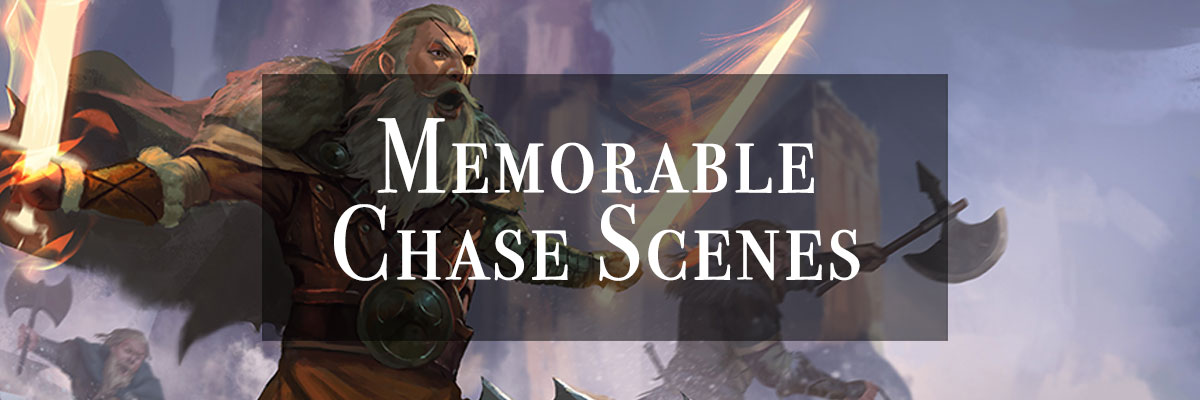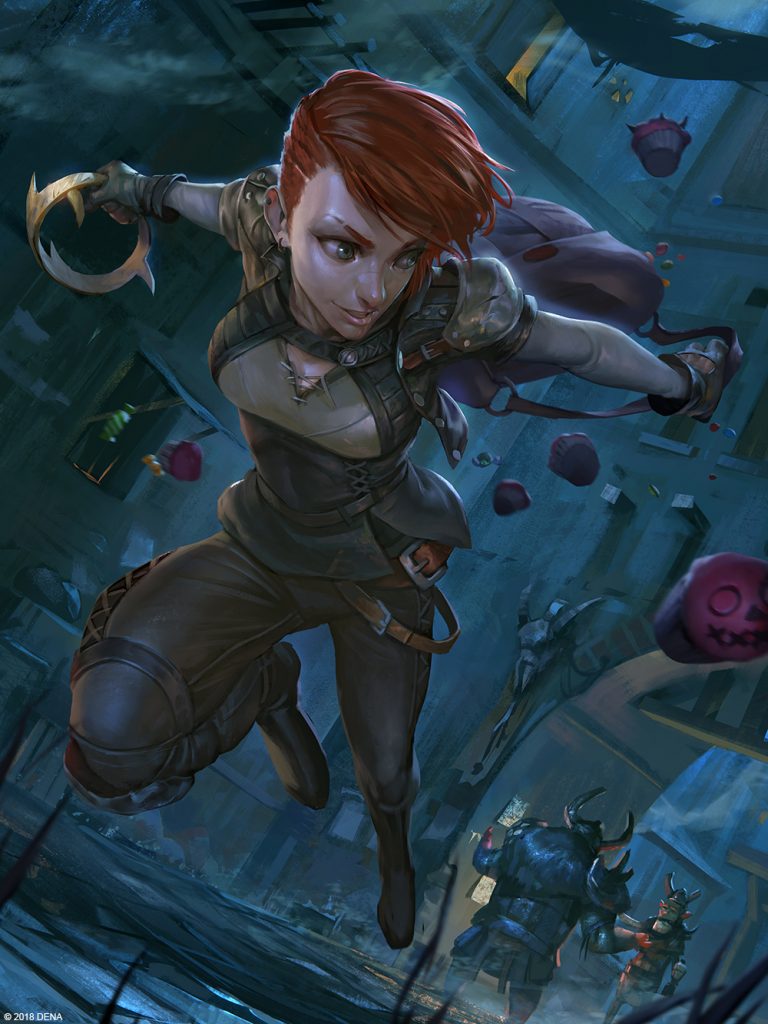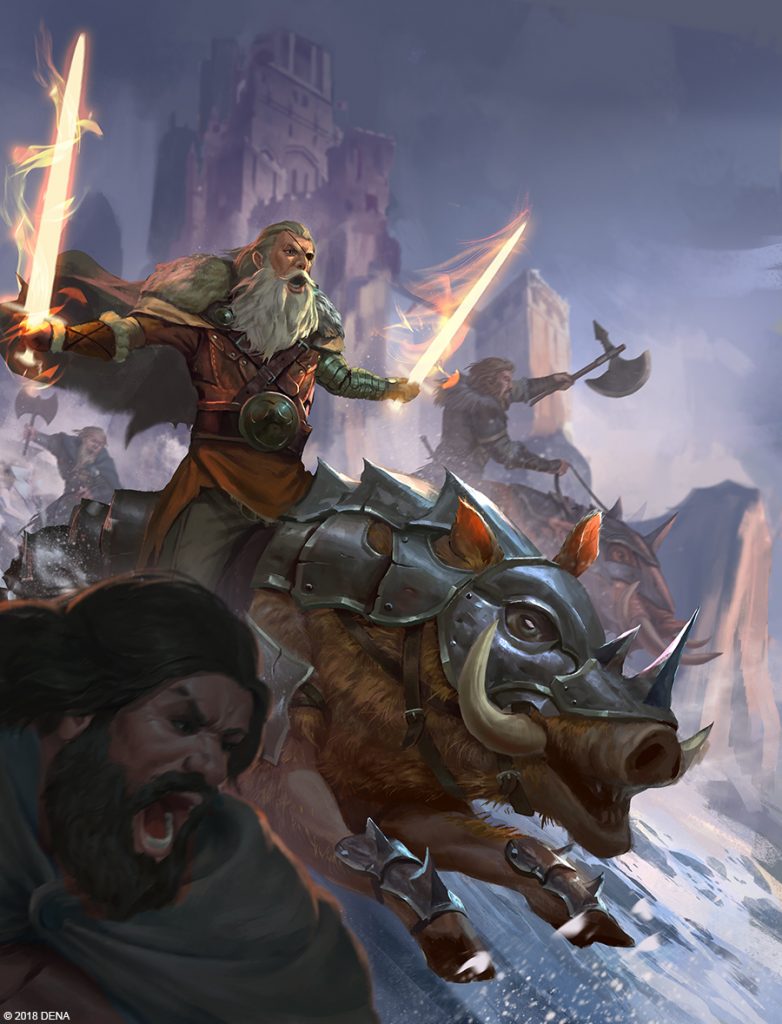DM’s Tool Chest: Create a Memorable Chase Scene

On page 252 of the 5e Dungeon Master’s Guide is the start of a three-page discussion on running chases. As a DM, you are encouraged to read that section if they are not already familiar with the many rules listed there. Running a chase scene can be a roaring success… or a snooze-fest failure if not executed properly. Pacing and complications are the two factors that must be balanced properly (whether the DM is using miniatures on a map or theater-of-the-mind) in order to pull off a chase scene that the players will never forget.
The Dungeon Master’s Guide offers a great place to start when it comes to chases, and it offers complication tables for Urban and Wilderness chase scenes. But if you have a unique locale you may need to dig a bit deeper to create a table of complications as well as some unique rules for this a one-of-a-kind chase. As an example, consider the following situation in which our heroes have found themselves:
Recent attacks on townsfolk by deceased family members returned as undead have the mayor on edge. The heroes have been hired to investigate and have been spending their nights in the cemetery looking for clues. In the darkness, the cemetery is a twisting and turning maze of collapsing crypts, twisted tombstones, open pits, and gnarled vines. In the distance, a green twinkle is spotted. As the heroes move in for a closer look, a kneeling figure in dark robes spots the group and turns to run.

Image © 2018 Blizzard Entertainment
From the setup, there are already a number of possible complications ready for a DM to use: tripping on a tombstone or some vines, falling into an open grave, and even an encounter with the undead. The mysterious figure has a slight head start, too. To prepare this encounter for your players will require a few things:
1. Determining the starting distance between quarry and pursuer(s)
2. Creating a complications table with reasonable events
3. Defining any unique rules for resolving actions and combat
As with all chase scenes, the greater the distance between the quarry and a pursuer the greater the chance the quarry will escape. If the DM wishes to give the pursuer better odds of capturing the prey, that distance will need to be reduced significantly. Factors such as whether the quarry has night vision, faster speed, or any special abilities must be taken into consideration, too. A good rule of thumb for a more likely capture is to have the initial distance between the quarry and lead pursuer equal to 2x the fastest party member movement speed minus the quarry’s movement speed. For a quarry speed of 25ft and a speed of 40 feet for the fastest hero, place the quarry 55 feet away; after two Dash actions, the fastest party member should be within striking distance given no major complications. (It is also assumed the quarry is also using Dash actions.)
For a greater chance of escape, the DM can increase the distance between the quarry and pursuer, but other options include giving the quarry an automatic 20 for initiative, knowledge of the land (for avoiding obstacles and being aware of places to hide), and/or adding complications (in this case, directing an undead to attack or possibly leading the party into a trap that was created by the quarry for this specific situation). For this situation, set the initial distance between the quarry and lead pursuer equal to 4x the fastest party member movement speed. For a quarry speed of 25 feet and a speed of 40 feet for the fastest hero, place the quarry 55 feet away; this will take six Dash actions to put the fastest party member within striking distance assuming no major complications have been rolled.

For theater-of-the-mind, the DM will need to rely on accurate descriptions as well as tracking of the positions of the quarry and the pursuers. With miniatures, the job will be a bit easier, but pulling surprises like open graves and vines will rely on the players believing that the night chase is filled with hazards, so the DM cannot ease up on vivid descriptions and maintaining a fast-paced encounter.
As for a complications table, this task can sometimes help create itself if you’ve written a detailed description of the locale and the situation. Using a d20, you’ll need to create 10 unique hazards or encounters, with a roll of 11-20 by a player indicating no complication. (Remember, each player will roll a d20 at the end of his or her turn AND any complication rolled is passed to the next player in the initiative order.) Creating realistic hazards is critical, so it’s important to consider the locale of the chase as well as any special abilities the quarry may possess. Here’s an example complications chart that fits well with the cemetery scene and a villain who can create undead:
Example Complication Table
| d20 Result | Complication |
|---|---|
| 1 | Lurching from the shadows, a zombie attempts to bite your arm. On a successful hit, the zombie deals normal damage and your speed is reduced by 10' on your next turn. |
| 2 | A rotting hand reaches up from the ground and grabs your ankle. Make a DC 14 Dexterity (Acrobatics) check to avoid falling. On a failed check, you lose your balance and slam into the side of a crypt, taking 1d4 bludgeoning damage. |
| 3 | In front of you is a gaping hole of a freshly dug grave. Make a DC 12 Dexterity (Acrobatics) check or tumble in and take 1d4 bludgeoning damage. On success, roll on the complication table again after jumping over the hole. |
| 4 | The quarry pushed over a large jar that was resting to the side of a crypt. It shattered, releasing a noxious cloud of poison gas. Make a DC 15 Constitution save or be poisoned until a short rest is taken. Maximum movement speed is reduced by 10'. Any pursuers within 15' must also make a Constitution save. |
| 5 | The quarry ducks behind a crypt, momentarily disappearing. Make a successful DC 12 Wisdom (Perception) check. On a failed check, you become distracted -- roll again on the complications table. |
| 6 | A wooden gate slams shut. Make a successful DC 16 Strength check to barrel through it. On a failed save, take 1d4 bludgeoning damage and the next pursuer must make a DC 14 Dexterity (Acrobatics) check to jump over the gate or go around and have movement speed reduced by 10' on next turn. |
| 7 | You trip over the remains of a shattered tombstone. Make a DC 12 Dexterity (Acrobatics) check to avoid falling. On a failed check, you lose your balance and fall prone. |
| 8 | The noise of your pursuit has drawn unwanted attention. A gray ooze drips down from the branches of a small tree. Make a DC 12 Dexterity (Acrobatics) check. On a failed check, the ooze attacks with advantage. |
| 9 | A vine snags your foot. Make a DC 10 Dexterity (Acrobatics) check to continue your pursuit. On a failed check, your movement speed is reduced by 10' on your next turn. |
| 10 | A vine snags your foot. Make a DC 10 Dexterity (Acrobatics) check to continue your pursuit. On a failed check, your movement speed is reduced by 10' on your next turn. |
| 11-20 | No complication. |
Complications will need to be adjusted based on the level of the characters, so tweak the DC values for saves as well as the CR values of creature encounters. You do not want random creatures controlling the chase, however, so don’t let them distract from the chase; if the characters are running, encounters should be quick and maybe even outrun or ignored with the right save or the right action. The chase should have risks, but not to the detriment of the main task – catching the villain.

Once you’ve got the distance set and the complication table created, it’s time to decide whether there are any special rules that need to be applied, and these should be kept to a bare minimum… one or two at most. These should not override the chase rules that the players may already know unless absolutely necessary. For this scenario, one additional rule will be added for fun:
Any cast spells or thrown or ranged weapons will have a chance to hit a pursuer if the initial attack on the quarry fails. On a failed attack by a pursuer, all pursuers within a 10’ wide line drawn between the attacker and the quarry are at risk of being hit; roll another attack at disadvantage against the nearest pursuer, and continue until all pursuers between attacker and quarry have avoided the attack or been hit.

This additional rule takes into account the darkness of the cemetery as well as the fact that the pursuers are running and dodging. This rules doesn’t forbid spellcasting or weapon attacks, but it may give players (especially those with characters towards the rear of the chase) a good reason to hesitate and think carefully about a possible attack.
Chases should be exciting and give each player a sense of real danger as they rush into a situation without preparation. Whether you wish the quarry to be captured or get away, the chase can be tailored to meet your goal as well as the enjoyment of your players. Keep it fast-paced, limit the combat when possible, and make the risks and consequences feel logical. Do all that, and you’ll have players rushing in to action more, whether there’s a chase planned or not.

James Floyd Kelly
Writer. Adventurer. Scoundrel.
James has worked as a freelance tech writer for over 12 years, producing over 30 books for five different publishers. A long-time gamer since middle school, he has written a number of 5e adventures for Goodman Games as well as articles for Wargames Illustrated and Miniature Wargames magazines.
James is a DM for Wednesday night’s Adventurers League at Titan Games & Comics in Atlanta. When not DMing, he can also be found writing for GeekDad.com on his current favorite gaming hobbies – D&D, Frostgrave, Star Wars Legion, and Gaslands. James can also be found on YouTube where he hosts Game Terrain Engineering, a channel devoted to creating terrain for tabletop games.
2 Comments
Leave a Reply
DM’s Tool Chest: Create a Memorable Chase Scene

On page 252 of the 5e Dungeon Master’s Guide is the start of a three-page discussion on running chases. As a DM, you are encouraged to read that section if they are not already familiar with the many rules listed there. Running a chase scene can be a roaring success… or a snooze-fest failure if not executed properly. Pacing and complications are the two factors that must be balanced properly (whether the DM is using miniatures on a map or theater-of-the-mind) in order to pull off a chase scene that the players will never forget.
The Dungeon Master’s Guide offers a great place to start when it comes to chases, and it offers complication tables for Urban and Wilderness chase scenes. But if you have a unique locale you may need to dig a bit deeper to create a table of complications as well as some unique rules for this a one-of-a-kind chase. As an example, consider the following situation in which our heroes have found themselves:
Recent attacks on townsfolk by deceased family members returned as undead have the mayor on edge. The heroes have been hired to investigate and have been spending their nights in the cemetery looking for clues. In the darkness, the cemetery is a twisting and turning maze of collapsing crypts, twisted tombstones, open pits, and gnarled vines. In the distance, a green twinkle is spotted. As the heroes move in for a closer look, a kneeling figure in dark robes spots the group and turns to run.

Image © 2018 Blizzard Entertainment
From the setup, there are already a number of possible complications ready for a DM to use: tripping on a tombstone or some vines, falling into an open grave, and even an encounter with the undead. The mysterious figure has a slight head start, too. To prepare this encounter for your players will require a few things:
1. Determining the starting distance between quarry and pursuer(s)
2. Creating a complications table with reasonable events
3. Defining any unique rules for resolving actions and combat
As with all chase scenes, the greater the distance between the quarry and a pursuer the greater the chance the quarry will escape. If the DM wishes to give the pursuer better odds of capturing the prey, that distance will need to be reduced significantly. Factors such as whether the quarry has night vision, faster speed, or any special abilities must be taken into consideration, too. A good rule of thumb for a more likely capture is to have the initial distance between the quarry and lead pursuer equal to 2x the fastest party member movement speed minus the quarry’s movement speed. For a quarry speed of 25ft and a speed of 40 feet for the fastest hero, place the quarry 55 feet away; after two Dash actions, the fastest party member should be within striking distance given no major complications. (It is also assumed the quarry is also using Dash actions.)
For a greater chance of escape, the DM can increase the distance between the quarry and pursuer, but other options include giving the quarry an automatic 20 for initiative, knowledge of the land (for avoiding obstacles and being aware of places to hide), and/or adding complications (in this case, directing an undead to attack or possibly leading the party into a trap that was created by the quarry for this specific situation). For this situation, set the initial distance between the quarry and lead pursuer equal to 4x the fastest party member movement speed. For a quarry speed of 25 feet and a speed of 40 feet for the fastest hero, place the quarry 55 feet away; this will take six Dash actions to put the fastest party member within striking distance assuming no major complications have been rolled.

For theater-of-the-mind, the DM will need to rely on accurate descriptions as well as tracking of the positions of the quarry and the pursuers. With miniatures, the job will be a bit easier, but pulling surprises like open graves and vines will rely on the players believing that the night chase is filled with hazards, so the DM cannot ease up on vivid descriptions and maintaining a fast-paced encounter.
As for a complications table, this task can sometimes help create itself if you’ve written a detailed description of the locale and the situation. Using a d20, you’ll need to create 10 unique hazards or encounters, with a roll of 11-20 by a player indicating no complication. (Remember, each player will roll a d20 at the end of his or her turn AND any complication rolled is passed to the next player in the initiative order.) Creating realistic hazards is critical, so it’s important to consider the locale of the chase as well as any special abilities the quarry may possess. Here’s an example complications chart that fits well with the cemetery scene and a villain who can create undead:
Example Complication Table
| d20 Result | Complication |
|---|---|
| 1 | Lurching from the shadows, a zombie attempts to bite your arm. On a successful hit, the zombie deals normal damage and your speed is reduced by 10' on your next turn. |
| 2 | A rotting hand reaches up from the ground and grabs your ankle. Make a DC 14 Dexterity (Acrobatics) check to avoid falling. On a failed check, you lose your balance and slam into the side of a crypt, taking 1d4 bludgeoning damage. |
| 3 | In front of you is a gaping hole of a freshly dug grave. Make a DC 12 Dexterity (Acrobatics) check or tumble in and take 1d4 bludgeoning damage. On success, roll on the complication table again after jumping over the hole. |
| 4 | The quarry pushed over a large jar that was resting to the side of a crypt. It shattered, releasing a noxious cloud of poison gas. Make a DC 15 Constitution save or be poisoned until a short rest is taken. Maximum movement speed is reduced by 10'. Any pursuers within 15' must also make a Constitution save. |
| 5 | The quarry ducks behind a crypt, momentarily disappearing. Make a successful DC 12 Wisdom (Perception) check. On a failed check, you become distracted -- roll again on the complications table. |
| 6 | A wooden gate slams shut. Make a successful DC 16 Strength check to barrel through it. On a failed save, take 1d4 bludgeoning damage and the next pursuer must make a DC 14 Dexterity (Acrobatics) check to jump over the gate or go around and have movement speed reduced by 10' on next turn. |
| 7 | You trip over the remains of a shattered tombstone. Make a DC 12 Dexterity (Acrobatics) check to avoid falling. On a failed check, you lose your balance and fall prone. |
| 8 | The noise of your pursuit has drawn unwanted attention. A gray ooze drips down from the branches of a small tree. Make a DC 12 Dexterity (Acrobatics) check. On a failed check, the ooze attacks with advantage. |
| 9 | A vine snags your foot. Make a DC 10 Dexterity (Acrobatics) check to continue your pursuit. On a failed check, your movement speed is reduced by 10' on your next turn. |
| 10 | A vine snags your foot. Make a DC 10 Dexterity (Acrobatics) check to continue your pursuit. On a failed check, your movement speed is reduced by 10' on your next turn. |
| 11-20 | No complication. |
Complications will need to be adjusted based on the level of the characters, so tweak the DC values for saves as well as the CR values of creature encounters. You do not want random creatures controlling the chase, however, so don’t let them distract from the chase; if the characters are running, encounters should be quick and maybe even outrun or ignored with the right save or the right action. The chase should have risks, but not to the detriment of the main task – catching the villain.

Once you’ve got the distance set and the complication table created, it’s time to decide whether there are any special rules that need to be applied, and these should be kept to a bare minimum… one or two at most. These should not override the chase rules that the players may already know unless absolutely necessary. For this scenario, one additional rule will be added for fun:
Any cast spells or thrown or ranged weapons will have a chance to hit a pursuer if the initial attack on the quarry fails. On a failed attack by a pursuer, all pursuers within a 10’ wide line drawn between the attacker and the quarry are at risk of being hit; roll another attack at disadvantage against the nearest pursuer, and continue until all pursuers between attacker and quarry have avoided the attack or been hit.

This additional rule takes into account the darkness of the cemetery as well as the fact that the pursuers are running and dodging. This rules doesn’t forbid spellcasting or weapon attacks, but it may give players (especially those with characters towards the rear of the chase) a good reason to hesitate and think carefully about a possible attack.
Chases should be exciting and give each player a sense of real danger as they rush into a situation without preparation. Whether you wish the quarry to be captured or get away, the chase can be tailored to meet your goal as well as the enjoyment of your players. Keep it fast-paced, limit the combat when possible, and make the risks and consequences feel logical. Do all that, and you’ll have players rushing in to action more, whether there’s a chase planned or not.

James Floyd Kelly
Writer. Adventurer. Scoundrel.
James has worked as a freelance tech writer for over 12 years, producing over 30 books for five different publishers. A long-time gamer since middle school, he has written a number of 5e adventures for Goodman Games as well as articles for Wargames Illustrated and Miniature Wargames magazines.
James is a DM for Wednesday night’s Adventurers League at Titan Games & Comics in Atlanta. When not DMing, he can also be found writing for GeekDad.com on his current favorite gaming hobbies – D&D, Frostgrave, Star Wars Legion, and Gaslands. James can also be found on YouTube where he hosts Game Terrain Engineering, a channel devoted to creating terrain for tabletop games.
2 Comments
-
The Bathrobe Wizard on October 4, 2018 at 7:25 am
I am totally ripping this off and making my players chase a bad guy through a graveyard!

I am totally ripping this off and making my players chase a bad guy through a graveyard!
Go for it — that’s why I wrote it. I hope the players enjoy it.